- 한국어
- English
- 日本語
- 中文
- العربية
- Español
- Français
- Deutsch
- Pусский
- Tiếng Việt
- Indonesian
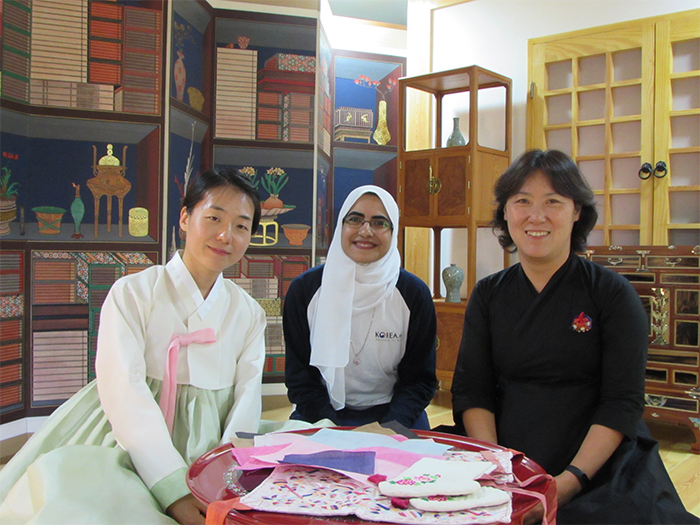
Professor Lee Seung-hae (left), Korea.net Honorary Reporter Esraa Elzeny (center) and Professor Choi Mi-sook pose for a photo at the Korean Cultural Center in Cairo.
Over two weeks, we enjoyed making heori chima dresses. A chima is a basic bottom dress-like article of clothing for women and is simply composed of a body, a belt and a rope. Hanbok sessions were at the beginner and advanced levels. During the beginner sessions, we learned how to sew in the Korean way. It was a wonderful feeling and we learned a lot. There were participants from all ages, in all the classes, and they weren't limited to women, either, as many men participated, too.
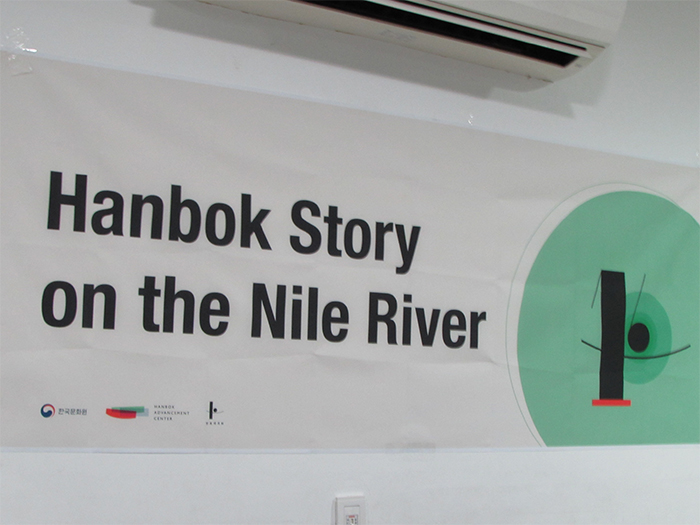
Hanbok classes were held under the title of 'Hanbok Story on the Nile River.'
Professor Choi Mi-sook and Professor Lee Seung-hae began this course, talking about the history of Hanbok and the stages of its development. It started nearly 5000 years ago, but it was only discovered in B.C. 2000. Hanbok started with one piece, like other global dresses, and developed to be the shape we know now. By virtue of the Silk Road, there are many Korean ornaments in Greece and Greek ornaments in Korea. The green color was really special to ancient Koreans, too.
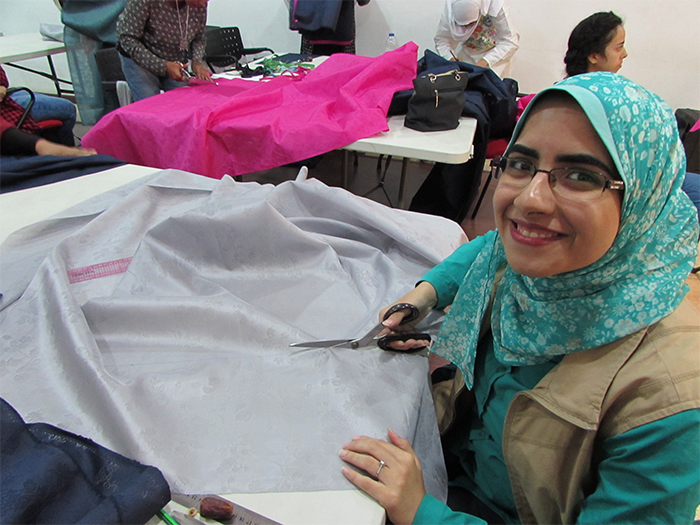
The class allows us to make our own heori chima dresses.
As the class began, we started by cutting out the fabric needed and then learned how to sew a heori chima dress. We interviewed Professor Choi Mi-sook and Professor Lee Seung-hae to learn more about Hanbok.
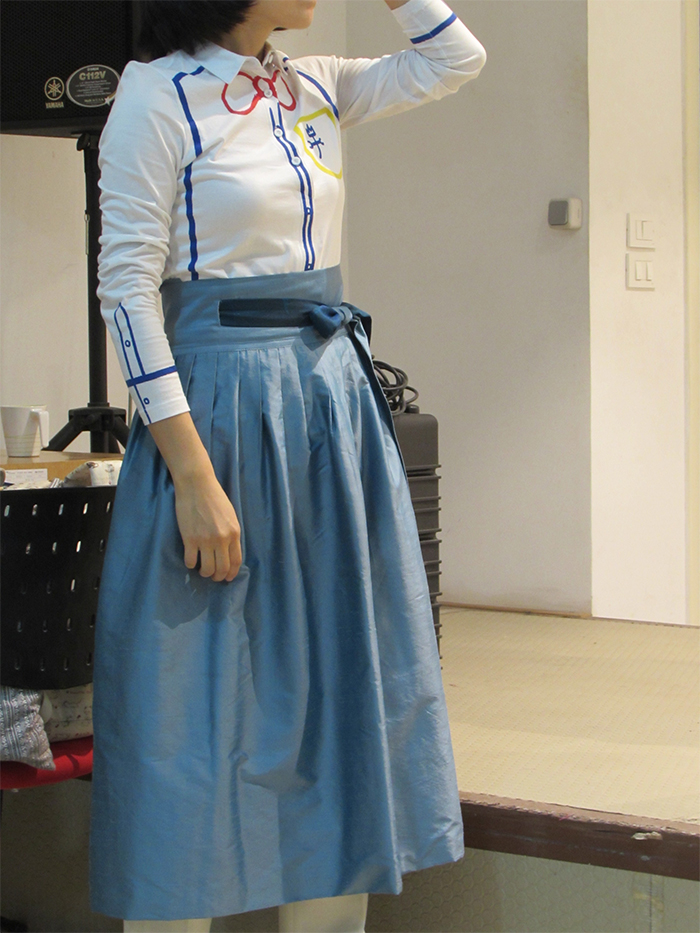
We made a heori chima dress during the sewing class.
For an hour and half, we talked with Professor Choi Mi-sook and Professor Lee Seung-hae about all sorts of matters relating to Hanbok. It was like talking to a close family member. Please find the text of our interview below.
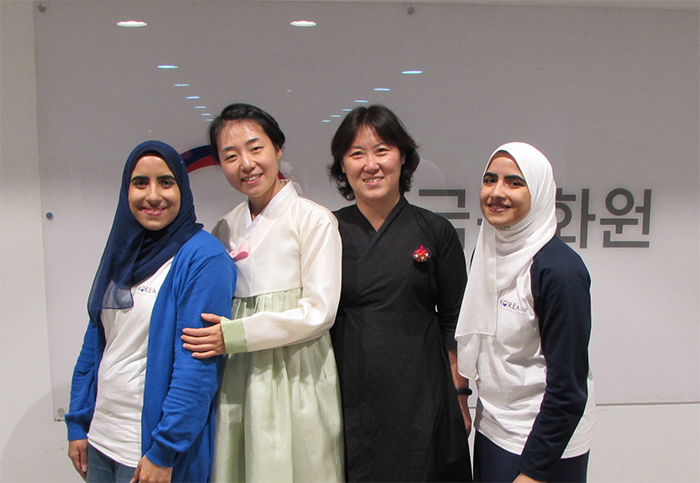
Korea.net Honorary Reporter Salwa Elzeny (left), Professor Lee Seung-hae (second from left), Professor Choi Mi-sook (third from left) and Korea.net Honorary Reporter Esraa Elzeny pose for a photo during a Hanbook sewing class.
Long ago, ancient Egyptians used linen because it was the only plant existing at the time. What plants did ancient Koreans use?
Moshi (모시) and ramie were used by most ancient Korean peoples, except that kings used silk, too. After the appearance of cotton, all the people used it in sewing and embroidery.
Which do today's Korean people prefer, modern Hanbok or classical Hanbok?
Koreans wear classical Hanbok at weddings, festivals and on special occasions, and in their everyday life sometimes wear modern Hanbok because it fixes the problems with classical Hanbok. It's easy to wear, comfortable to use, has various colors and new fabrics are used to make it.
India is known for its handmade products and embroidery. These products were transferred to the whole world. Why has Hanbok not spread that much, even though it's convenient for every time and place?
Sixty years is not enough time to transfer Korean culture, but the Koreans put plans to spread Hanbok and the Korean culture. The Korean Cultural Centers around the world play this role now, to let people know more about Hanbok. The efforts are simple, but they're trying, and the beginning will be in October in Egypt and then in the U.K. and France. Many designers are holding Hanbok fashion shows all around the world and also dramas help to spread the culture of Hanbok all over the world.
Professor Choi Mi-sook now wants to open a channel on YouTube displaying the way to make Hanbok. After she came to Egypt and saw that there are Egyptians who speak Korean and are interested in Hanbok, she decided to double her efforts in order to spread Hanbok to everyone who's interested in Hanbok. She also says that the workshops are very important to spread Korean culture and civilization.
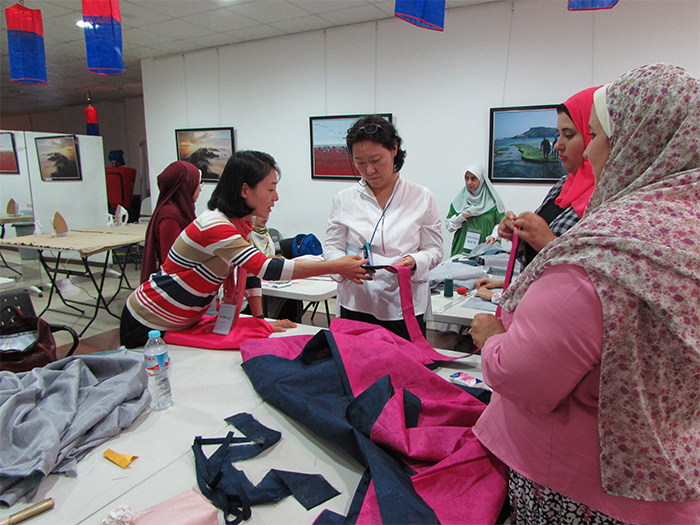
Professor Lee Seung-hae helps us make our own Hanbok.
How do I know that the Hanbok I want to buy is well suited for my body and is of good quality?
The most important thing when you choose a Hanbok is that you're impressed with Hanbok and that it looks beautiful. There are many clever Hanbok makers and they are proficient in the Hanbok industry, but the most important thing is selecting the raw materials and colors of your Hanbok. In order to choose properly, you must watch a lot of dramas and a lot of Hanbok fashion shows in order to gain experience in how to choose. You must conceptualize the Hanbok that you want to buy and in the Dongdaemun market there are a lot of professionals in the Hanbok industry.
Koreans always choose things that are significant. What are the significances of colors on the sleeves of Hanbok?
Hanbok with many colors was used for the young and old because it's delightful and all these colors are indicative and take from the five basic Korean colors. These colors symbolize good and evil, cold and hot. Mothers choose the colors for their children because she knows what suits them. White and black are neutral shades, so we don't use them in children's Hanbok, and children usually wear delightful colors, not black. There are specific colors, such as blue for boys, and scarlet for girls. All the colors are beautiful, but you must choose a suitable color for you and choose delightful colors.
Why isn't Hanbok seen at weddings? Why do Koreans prefer to wear a white wedding dress and a suit?
No, Hanbok weddings still exist, but it depends on the couple's background. If the wedding was in a village, the Korean couple was committed to wearing Hanbok, but if it was in a city, they wore a white dress and a suit in the past. In Korea, the husband goes to his bride's family's house and when they have children return back to his parents' house. It is essential that the groom must wear Hanbok when he goes to his bride's family's house for the first time, because it's Korean tradition.
What are the characteristics of Hanbok in each season of the year?
Koreans wore ramie fabric in the summer, cotton or any heavy material in the winter and silk between the seasons. Currently, they wear any material because of air conditioning.
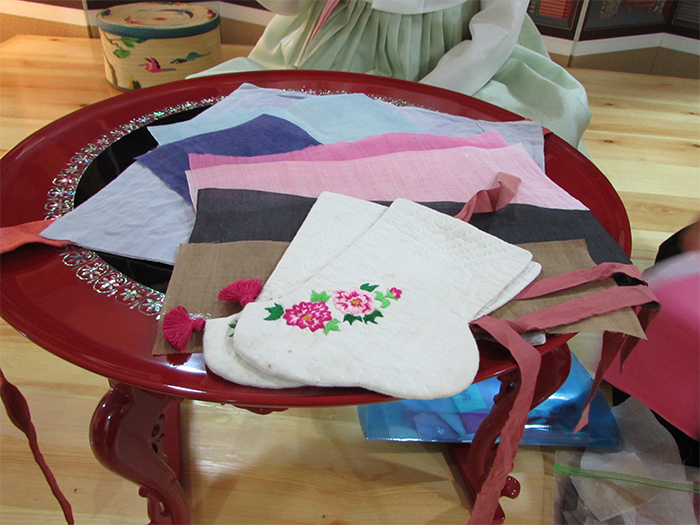
The raw materials for Hanbok are quite beautiful.
What attracted you to study Hanbok?
Professor Choi specialized in natural dyes and Professor Lee specialized in Hanbok design. Both of us were attracted to Hanbok in spite of our differences in specialization, but studying in depth made us learn the smallest details, and this made us learn about different cultures and many raw materials.
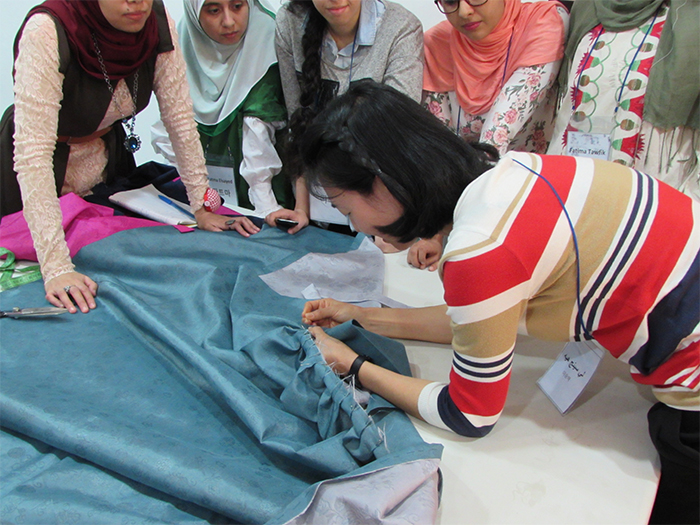
Professor Lee Seung-hae shows us how to make a heori chima dress.
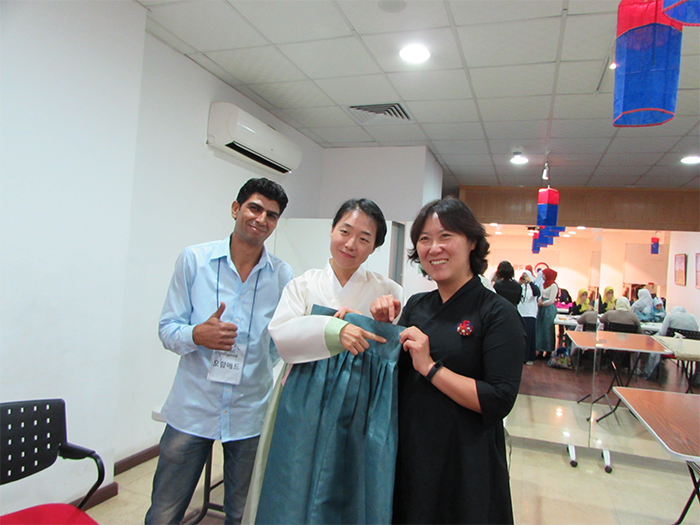
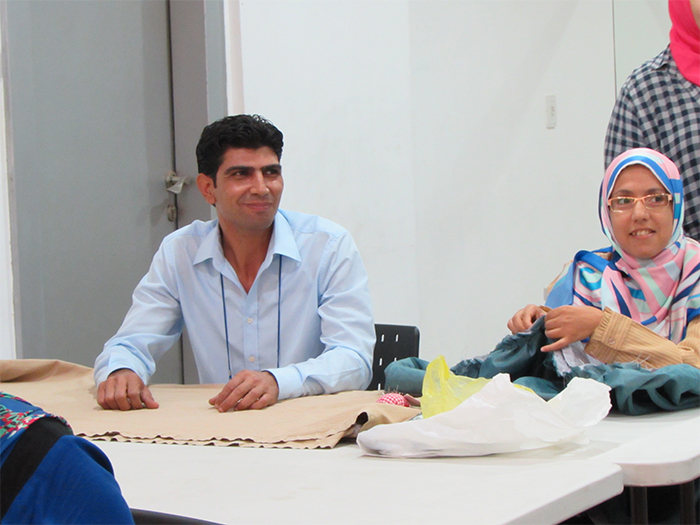
Mohamed was the only man at the sessions and he was the best student there.
The session ended and in the last part, Professor Choi said, "In the opening session, I wanted to know why you wanted to make Hanbok, but I was impressed that there are many people who love Korea. It has affected me to see how students want to learn new things, different from their culture." Professor Lee said, "I was very worried, but many students finished their Hanbok sewing. I wish that the place can be equipped with more equipment, but students surpassed all expectations. Although sewing methods were different, all the students finished their Hanbok and they were happy to do so."
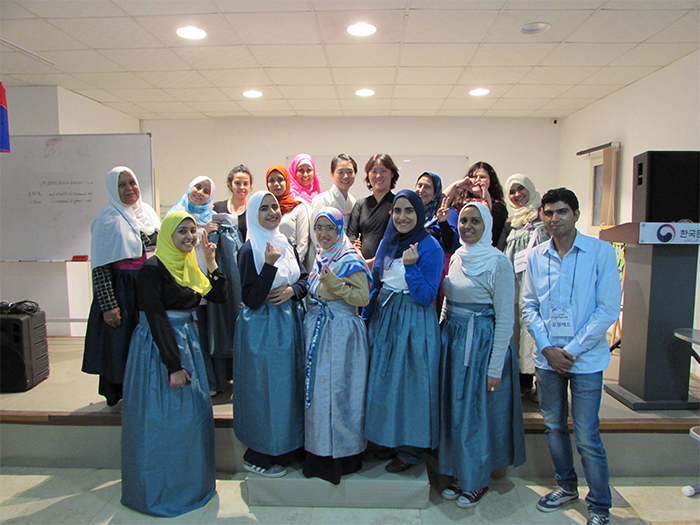
Attendees at the sewing class pose for a photo.
The professors’ tears and their charming words affected us. Most Korean professors cry when they leave their beloved Korea. The Korean people are sensitive and kind by nature, so wherever they go, they leave an imprint and make everyone who deals with them admire these people.
October is the month of Hanbok in Egypt. After the completion of the Hanbok sewing sessions, the Korean Cultural Center in Cairo and the Korean Embassy in Egypt held the first ever Hanbok fashion show in Egypt and in the Middle East. Many Egyptian models, people who love Korean culture and many Korean residents in Cairo, participated in this show. The show took place at one of Cairo’s five-star hotels, the Hilton Ramses Hotel. Egyptian press followed the event closely and here you can find what was published about the Hanbok show.
http://weekly.ahram.org.eg/News/17741/25/Hanbok-on-the-Nile.aspx
The al-Ahram weekly newspaper is an official national newspaper in Egypt.
By Esraa Elzeny
Korea.Net Honorary Reporter
Photos: Esraa Elzeny, Korea Culture Diplomatic Mission Facebook page